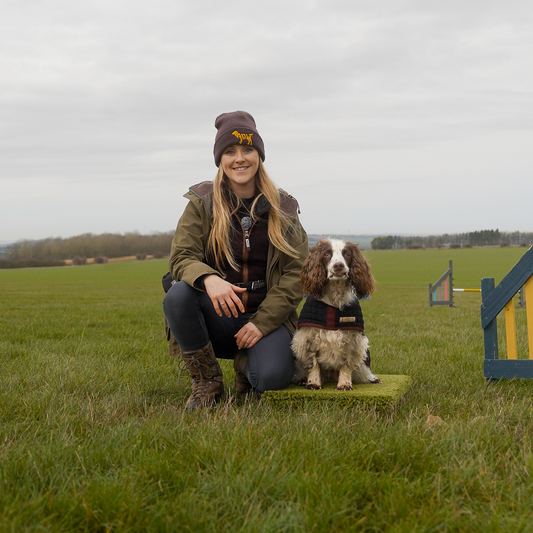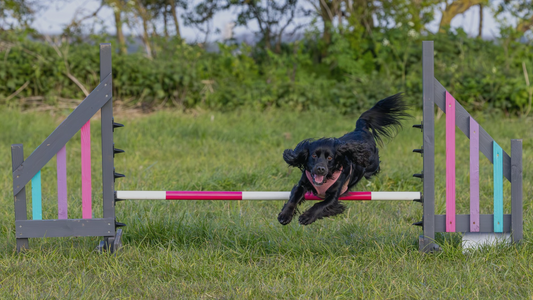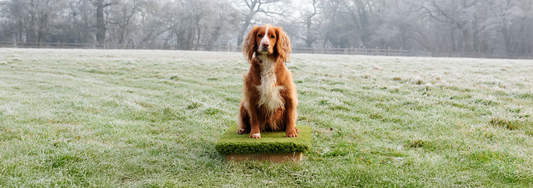Understanding Dog Training Boards: Key Tool for your Training Toolbox
The Role of Training Boards in Canine Obedience: What They Are and How They Work
Training a dog can be challenging, especially when trying to clearly communicate what you want to a dog that doesn't speak your language. A tool that is becoming increasingly popular among professional trainers and dog owners is the dog training board, also known as a place board. But what exactly is it, and why is it such an effective tool?
What is a Dog Training Board?
A dog training board is a raised platform, usually with a textured surface, that serves as a target area for your dog during training. It provides a clear boundary and a distinct surface, helping to reinforce cues and enhance your dog's focus. Place boards can be used to teach a variety of behaviours, from basic obedience like sit and stay to advanced skills like directional commands in gundog training.
Training boards simplify communication between handler and dog by making it crystal clear where your dog is expected to be. When your dog is on the board, they receive tactile feedback from the surface, helping them distinguish between correct and incorrect positions; the elevated platform of the Place Board makes this learning clearer for your dog, as it is more obvious if all 4 paws are on the board, as opposed to using a carpet tile for example, which has less clear boundaries.
Why Use a Training Board for Dogs?
-
Clear Boundaries
A training board provides a physical boundary that helps your dog understand where they need to be. This clarity reduces confusion, making it easier to teach behaviours like “sit,” “stay,” and “place.” -
Builds Confidence
Consistent training on a place board builds your dog’s confidence. They learn that being on the board results in rewards and praise, creating a positive association. This confidence carries over to more complex training exercises and real-life situations. -
Focus and Engagement
A board draws your dog’s attention, enhancing focus during training sessions. It becomes a clear target, making it easier to guide your dog and reduce distractions. -
Reinforces Position
For commands that require your dog to be in a specific spot—like sitting or waiting—a training board acts as a reliable marker. Your dog quickly learns that success (and treats!) comes from being on the board.
How Does a Training Board Work?
Training boards act as a target for your dog, guiding them to specific positions during exercises. The key lies in the combination of visual and tactile cues that the board provides. Here's a breakdown of how they are typically used:
-
Step 1: Introducing the Board – T.A.R.G.E.T Training
The first phase of place board training is all about creating a positive association. This stage is crucial because the feelings your dog develops now will influence every behavior you teach later. By attaching a positive emotion to the place board, your dog will learn to love both the board itself and any behaviours connected to it.
-
Step 2: Reinforcing Basic Commands
Once your dog is comfortable with the board, you can begin reinforcing basic commands such as sit-stay and steadiness around distractions while on the board. The distinct surface helps your dog understand when they’re in the correct position. -
Step 3: Advanced Training
With a solid foundation, you can use the board to teach more advanced skills, like reliable recalls, directional movements, and retrieves. The board remains a consistent focal point that reinforces correct behaviour.
Training Techniques Using a Place Board
Below are some practical exercises to get the most out of a dog training board:
1. Place Command Training
- Objective: Teach your dog to go to a specific spot and stay.
- How: Use treats to lure your dog onto the board. Once they’re on it, give the command “Place” and reward them. Through associative learning (hearing the word as they're doing the action) your dog will learn what "place" means. Gradually increase the distance between you and the board to build independence.
2. Sit-Stay Drill
- Objective: Reinforce steadiness and impulse control.
- How: Have your dog sit on the board. Gradually step away, rewarding them for staying put. If they step off, calmly guide them back without a treat, reinforcing the behavior you want.
3. Recall with Precision
- Objective: Teach your dog to return to you accurately.
- How: Use the board as a target for recall. Place it in front of you, call your dog back, and reward them when they land on the board. This teaches your dog to come directly to you rather than stopping short.
4. Directional Commands for Gundogs
- Objective: Develop reliable directional skills.
- How: Use multiple boards to teach left, right, and back commands. Start with one board, then add more as your dog’s skills progress. The clear target makes it easier for your dog to understand what you’re asking.
Common Questions About Training Boards
1. Can a training board be used for all breeds?
Absolutely. While training boards are especially popular in gundog training, they are effective for any breed. Whether you have a working dog or a family pet, a training board can simplify teaching commands.
2. What size should a training board be?
A standard 60 x 40cm top will work for most breeds; two boards touching along the long side, can be used to make a larger surface, if needs for those that are less confident or lack proprioception.
3. How long does it take to see results?
Every dog learns at a different pace, but many owners notice improvements in focus and obedience in the first session, with significant improvement within a week. Consistency and patience are key.
Benefits of Training with a Place Board
-
Improves Communication
The board serves as a communication tool, providing dogs with a clear understanding of where they need to be. This reduces the number of mistakes and speeds up learning. -
Enhances Motivation
Many dogs find training on a board exciting; it keeps them motivated and eager to train. -
Facilitates Complex Training
Using a board simplifies complex commands by breaking them down into smaller, clearer steps. It’s a valuable tool for teaching directional commands, steady stays, and more.
Tips for Effective Training with a Dog Board
- Start Small: Begin with simple commands like “sit” and “stay.” Use treats to lure your dog onto the board, rewarding them when they succeed.
- Keep Sessions Short: Training should be fun, not frustrating. Short sessions keep your dog engaged and prevent them from getting overwhelmed.
- Be Consistent: Consistency is crucial. Use the same commands and cues each time, reinforcing them with positive rewards.
Conclusion: Why Every Dog Owner Should Consider a Training Board
A dog training board is a simple yet powerful tool that can transform your training sessions. It provides clarity, builds confidence, and enhances communication between you and your dog. Whether you’re starting with basic commands or working on advanced skills, a place board helps create a well-trained and confident dog.
At Anglian Dog Works, we’re passionate about providing dog owners with the tools and knowledge they need to succeed. Explore our resources, and discover how a training board can be a game-changer in your dog’s obedience training.






